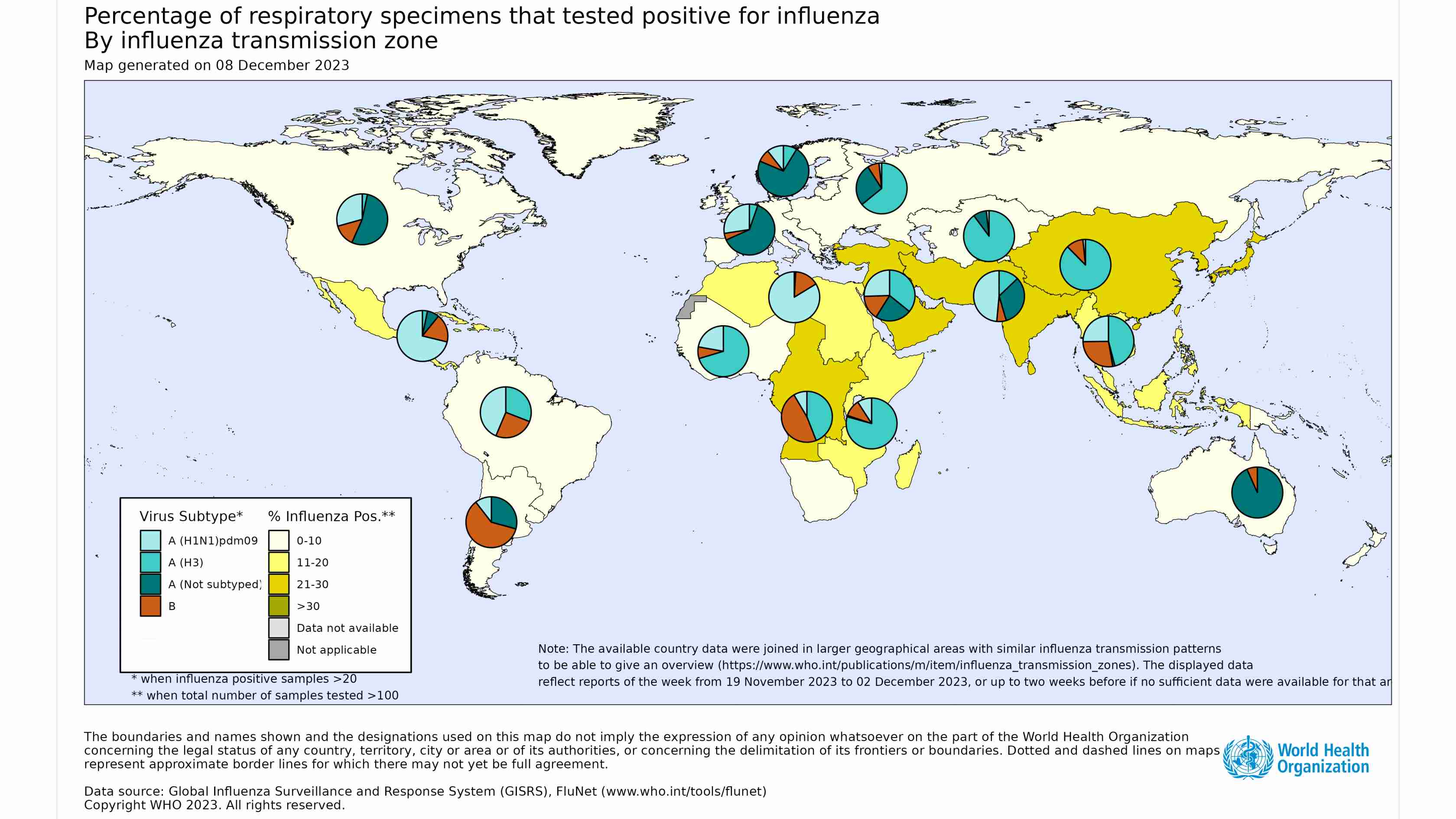Influenza Update N° 460

Overview
11 December 2023, based on data up to 26 November 2023
Information in this report is categorized by influenza transmission zones, which are geographical groups of countries, areas or territories with similar influenza transmission patterns. For more information on influenza transmission zones, see the link below:
Influenza Transmission Zones (pdf, 659kb)
- Countries are recommended to monitor the relative co-circulation of influenza and SARS‑CoV-2 viruses in integrated surveillance and report to RespiMART (FluNet and FluID) directly or via regional platforms. Clinicians should consider influenza in differential diagnosis, especially for high-risk groups for influenza, and test and treat according to national and WHO guidance.
- Globally, influenza detections increased due to increases in parts of the temperate Northern hemisphere, including parts of Europe and Central Asia, North America, and Eastern and Western Asia.
- In the countries of North America, influenza detections increased and activity was above the seasonal baseline and within expected levels for the time of year. Influenza A(H1N1)pdm09 viruses predominated among the detections.
- In Europe and Central Asia, in the most recent week, influenza activity remained low overall but has been increasing over the past few weeks. Of forty reporting countries, activity was reported at medium intensity in six, low intensity in twelve and below baseline in the others, and geographic spread was widespread in four reporting countries. Among the influenza detections in primary care sentinel surveillance, influenza A viruses predominated with similar numbers of A(H1N1)pdm09 and A(H3N2) virus detections.
- In Northern Africa, detections of predominantly influenza A(H1N1)pdm09 were elevated, mainly due to activity in Egypt.
- In East Asia, influenza activity continued to increase mainly due to activity in China and the Republic of Korea, with influenza A(H3N2) and A(H1N1)pdm09 viruses more frequently detected, respectively.
- In Western Asia, influenza activity remained elevated in some countries of the Arabian Peninsula and remained low in other reporting countries.
- In the Central American and Caribbean countries, influenza activity remained moderate in the Caribbean with detections of predominantly influenza A(H1N1)pdm09 and remained low but increased in Central America with detections of predominantly B/Victoria lineage viruses.
- In tropical south America, influenza activity remained low.
- In tropical Africa, influenza detections decreased in Western Africa but increased in Eastern and Middle Africa. Influenza A(H3N2) viruses were predominant but all seasonal influenza subtypes were reported.
- In Southern Asia, influenza activity driven predominantly by influenza A(H1N1)pdm09 decreased overall due to decreases in Iran (Islamic Republic of) and India.
- In South-East Asia, influenza activity driven by all seasonal subtypes decreased overall, however influenza detections of all seasonal subtypes increased in Cambodia.
- In the temperate zones of the southern hemisphere, indicators of influenza activity were reported at low levels or the below seasonal threshold in most reporting countries.
- National Influenza Centres (NICs) and other national influenza laboratories from 122 countries, areas or territories reported data to FluNet for the period from 13 November 2023 to 26 November 2023 (data as of 08/12/2023 06:22:56 AM UTC). The WHO GISRS laboratories tested more than 301 639 specimens during that period. 36 530 were positive for influenza viruses, of which 32 078 (87.8%) were typed as influenza A and 4861 (12.2%) as influenza B. Of the sub-typed influenza A viruses, 4861 (18.6%) were influenza A(H1N1)pdm09 and 21 327 (81.4%) were influenza A(H3N2). Of the type B viruses for which lineage was determined, all (2892) belonged to the B/Victoria lineage.
- Globally, SARS-CoV-2 positivity from sentinel surveillance decreased to just above 3%. Positivity was highest in the European Region, where it was stable at around 15%. Positivity was stable around or below 5% in the other regions. SARS-CoV-2 positivity from non-sentinel surveillance was around 16% globally.
- In countries with RSV surveillance in place, RSV activity increased in North America and Europe, with activity above the seasonal threshold in most reporting countries in Europe. Activity remained elevated in Central America and the Caribbean and was generally low or decreasing elsewhere.
- WHO encourages countries, especially those that have received the multiplex influenza and SARS-CoV-2 reagent kits from GISRS, to conduct integrated surveillance of influenza and SARS-CoV-2 and report epidemiological and laboratory information in a timely manner to established regional and global platforms. The guidance can be found here: https://covid.comesa.int/publications/i/item/WHO-2019-nCoV-integrated_sentinel_surveillance-2022.1.
- NICs and other national influenza laboratories from 80 countries, areas or territories from six WHO regions (African Region: 12; Region of the Americas: 18; Eastern Mediterranean Region: 6; European Region: 31; South-East Asia Region: 7; Western Pacific Region: 6) reported to FluNet from sentinel surveillance sites for time period from 12 November 2023 to 26 November 2023 (data as of 08/12/2023 06:22:56 AM UTC). The WHO GISRS laboratories tested more than 27 132 sentinel specimens during that period and 1199 (4.4%) were positive for SARS-CoV-2. Additionally, more than 26 830 non-sentinel or undefined reporting source samples were tested in the same period and 4684 were positive for SARS-CoV-2. Further details are included at the end of this update.
Source of data
______________________________________________________________________________________________
The Global Influenza Programme monitors influenza activity worldwide and publishes an update every two weeks. The updates are based on available epidemiological and virological data sources, including FluNet (reported by the WHO Global Influenza Surveillance and Response System), FluID (epidemiological data reported by national focal points) hosted by WHO RespiMART platform and influenza and other respiratory virus reports from WHO Regional Offices and Member States. During the COVID-19 pandemic, FluNet has also been receiving updates on testing of samples obtained from routine influenza surveillance systems for SARS-CoV-2. Completeness can vary among updates due to availability and quality of data available at the time when the update is developed.
*It includes data only from countries reporting on positive and negative influenza specimens.

